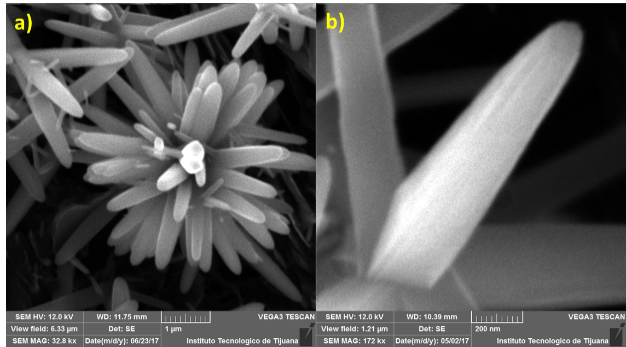Síntesis de película delgada de microesferas abiertas de nanovarillas de TiO2 aplicado como sensor electroquímico de Hg2+
DOI:
https://doi.org/10.37636/recit.v3296105Palabras clave:
TiO2, Nanovarillas, Sensor, Electroquímico, Mercurio.Resumen
El mercurio (Hg) es uno de los contaminantes más tóxicos, se ha convertido en una amenaza seria para la salud humana y el ambiente. Su exposición, produce efectos tóxicos graves en seres vivos, afectando los sistemas: nervioso, digestivo e inmunitario, y otras partes del organismo. El impacto ambiental es significativo y requiere la atención de todas las partes involucradas. Por esta razón, el desarrollo de métodos analíticos para la detección de bajas concentraciones de Hg en diferentes muestras es un asunto de interés científico. Actualmente, el uso de óxido de titanio (TiO2) ha revolucionado diversos campos generando nuevas aplicaciones tecnológicas. El área de sensores no ha quedado ajena a esta revolución debido a las propiedades de este material. En este trabajo de investigación, se da a conocer el desarrollo de un sensor electroquímico novedoso para la determinación de ultratrazas de mercurio en agua, a partir de nano-flores de TiO2 orientados. La síntesis del material se realizó sobre un sustrato de carbono (grafito) por el método hidrotérmico. La determinación de Hg2+ en agua fue realizada mediante voltamperometría cíclica y de pulso diferencial. Las pruebas electroquímicas del sensor mostraron una sensibilidad, selectividad y estabilidad alta, así como un amplio intervalo de detección en ppb
Descargas
Citas
F. Londoño-franco, T. Londoño-muñoz, G. Muñoz-garcía, “Los riesgos de los metales pesados en la salud humana y animal”. Biotecnol. en el Sect. Agropecu. y Agroindustrial, vol. 14, no. 2, pp. 145–153, 2016. https://doi.org/10.18684/BSAA(14)145-153. DOI: https://doi.org/10.18684/BSAA(14)145-153
D. Martín-Yerga, A. Costa-García, “Recent Advances in the Electrochemical Detection of Mercury”, Curr. Opin. Electrochem., vol. 3, no. 1, pp. 91–96, 2017. https://doi.org/10.1016/j.coelec.2017.06.012. DOI: https://doi.org/10.1016/j.coelec.2017.06.012
Norma Oficial Mexicana NOM-127-SSA1-1994, Salud ambiental, agua para uso y consumo humano-limites permisibles de calidad y tratamientos a que debe someterse el agua para su potabilización. http://www.salud.gob.mx/unidades/cdi/nom/127ssa14.html.
Y. Zhou, Y. Yang, X. Deng, G. Zhang, Y. Zhang, C. Zhang, S. Shuang, Y. He, W. Sun,“Electrochemical sensor for determination of ractopamine based on aptamer/octadecanethiol Janus particles”, Sensors and Actuators B: Chemical, vol. 276, pp. 204-210,2018. https://doi.org/10.1016/j.snb.2018.08.110. DOI: https://doi.org/10.1016/j.snb.2018.08.110
M. Begoña, G. García, C. García, “Los Biosensores Electroquímicos: Herramientas de La Analítica Y Del Diagnóstico Clínico”., vol. 6, pp. 197–222, 2010. http://hdl.handle.net/10651/11669.
O. Alev, E. Şennik, N. Kılınç, Z. Öztürk, “Gas Sensor Application of Hydrothermally Growth TiO2 Nanorods”, Procedia Eng., vol. 120, pp. 1162–1165, 2015. https://doi.org/10.1016/j.proeng.2015.08.747. DOI: https://doi.org/10.1016/j.proeng.2015.08.747

Publicado
Cómo citar
Número
Sección
Categorías
Licencia
Derechos de autor 2020 Juan José Hinostroza-Mojarro, Mirza Mariela Ruiz Ramírez, Carolina Silva Carrillo, Rosa Maria Felix Navarro, Paul Antonio Valle Trujillo, Balter Trujillo Navarrete

Esta obra está bajo una licencia internacional Creative Commons Atribución 4.0.
Los autores/as que publiquen en esta revista aceptan las siguientes condiciones:
- Los autores/as conservan los derechos de autor y ceden a la revista el derecho de la primera publicación, con el trabajo registrado con la licencia de atribución de Creative Commons 4.0, que permite a terceros utilizar lo publicado siempre que mencionen la autoría del trabajo y a la primera publicación en esta revista.
- Los autores/as pueden realizar otros acuerdos contractuales independientes y adicionales para la distribución no exclusiva de la versión del artículo publicado en esta revista (p. ej., incluirlo en un repositorio institucional o publicarlo en un libro) siempre que indiquen claramente que el trabajo se publicó por primera vez en esta revista.
- Se permite y recomienda a los autores/as a compartir su trabajo en línea (por ejemplo: en repositorios institucionales o páginas web personales) antes y durante el proceso de envío del manuscrito, ya que puede conducir a intercambios productivos, a una mayor y más rápida citación del trabajo publicado (vea The Effect of Open Access).











